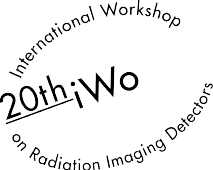Speaker
Description
Owing to their radiation hardness, 3D pixel sensors are the most promising option for the innermost layers of tracking detectors at the High Luminosity LHC (HL-LHC). This application requires very high hit-rate capabilities, increased pixel granularity, extreme radiation hardness, and low material budget. As a result, future 3D pixels will have all geometries significantly downscaled as compared to the existing ones, and in particular, a smaller pitch (e.g., 50$\times$50 or 25$\times$100 $\mu$mˆ2) and reduced active thickness (~100 $\mu$m). To this purpose, a new generation of 3D pixel sensors has been developed in the past few years within the “Phase2” INFN-FBK collaboration, using a single-sided technology on Si-Si Direct Wafer Bonded 6” substrates [1]. Beam test results of the first prototypes are encouraging, with hit efficiency values of ~99% (before irradiation) and ~97% (after irradiation to ~1 $\times$10$ˆ{16}$ n$_{eq}$ cm$ˆ{-2}$).
The sensor performance at larger fluences of interest for the HL-LHC could not be measured yet due to the limited radiation tolerance of the available read-out chips (FEI4 and PSI46dig). Nevertheless, TCAD simulations incorporating advanced radiation damage models anticipate that charge trapping effects are strongly mitigated in these small-pitch 3D sensors, so that the charge collection efficiency can be still very good (~70%) after an irradiation fluence of 2$\times$10$ˆ{16}$ n$_{eq}$ cm$ˆ{-2}$. In order to confirm the simulation results, we used 3D diodes, e.g., small (~2 mmˆ2) arrays of basic 3D cells with all columns of the same doping type shorted together, reproducing the same layout details of their parent pixel sensors. Sensors were irradiated with neutrons at the TRIGA Mark II reactor at JSI (Ljubljana, Slovenia) to three different fluences: 1$\times$10$ˆ{16}$, 2$\times$10$ˆ{16}$, and 3.5$\times$10$ˆ{16}$ n$_{eq}$ cm$ˆ{-2}$. The breakdown voltage of the irradiated samples, generally higher than 200 V, ensures a wide bias voltage range that is essential to obtain high efficiency [2]. For functional tests, we have used a vacuum chamber allowing to operate the samples at -15°C. The samples are contacted from the back side by placing the silicon dice on a metallic thermal finger covered with a conductive paste that improves the electrical contact. The signals are read-out from the front side by contacting the probing pads by microneedles. The read-out chain includes a low-noise charge amplifier and a shaper. By using a position resolved pulsed laser (wavelength 1055 nm, nominal pulse width 40 ps), we have collected two-dimensional maps of the relative signal intensity across a 3D basic cell at different bias voltages. Data were then normalised to the signals acquired on non-irradiated samples. The relative efficiency reaches ~75% for sensors irradiated to the smallest fluence and ~55% for those irradiated to the highest one. The 2-d signal maps were compared to those calculated according to Ramo’s theorem with input data obtained from TCAD simulations, and the agreement is satisfactory.
A comprehensive overview of the experimental and simulation results will be reported at the conference.
REFERENCES
[1] D.M.S. Sultan, et al., First production of new thin 3D sensors for HL-LHC at FBK, Journal of Instrumentation, JINST 12, C01022, 2017.
[2] G.-F. Dalla Betta, et al., Electrical characterization of FBK small-pitch 3D sensors after $\gamma$-ray, neutron and proton irradiations, Journal of Instrumentation, JINST 12, C11028, 2017.




